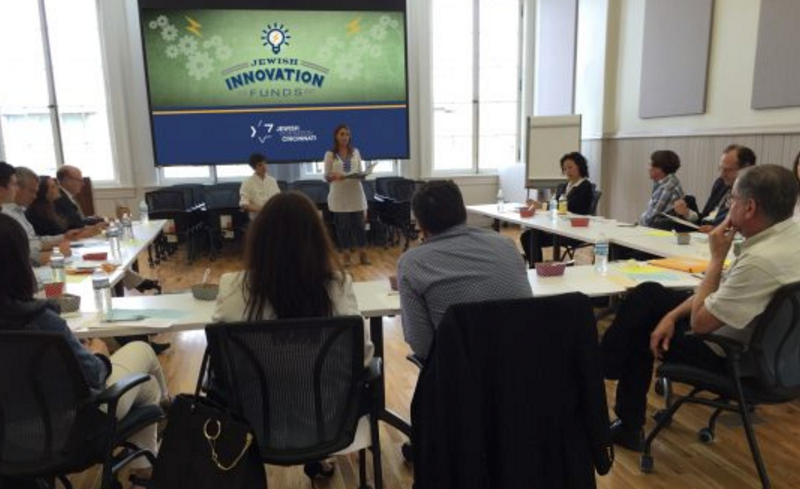David Harris

On-the-Ground Lessons from Our First Federation Giving Circle
By Ariel Weiss
Last November, one of our major donors at the Jewish Federation of Cincinnati said he was looking for a more engaged way to give to Jewish causes that mattered to him. We’d heard this before, and so we decided try something new: a giving circle.
At the Jewish Federation of Cincinnati, where the annual campaign is prime, we are very cautious about if, when and how we introduce new philanthropic messages. We have systems in place to educate, engage, connect, cultivate and steward potential and current donors. And we do all of this pretty well. Yet even the best fundraising organizations need to constantly innovate to tap the tremendous potential of new ideas, in an ever-changing philanthropic and economic landscape.
With both our donors and organizational growth in mind, six months ago we began the process of creating our giving circle as a philanthropic vehicle to better engage major donors. A giving circle is a community of friends, family or co-workers who join together to give in a meaningful way that benefits the nonprofit world. We just completed our first year, raising $80,000 and allocating all of these dollars to support innovation in Cincinnati’s Jewish community.
Here is what we’ve learned so far about giving circles as a philanthropic vehicle:
- It’s a team effort – Our CEO, Chief Development Officer, other fundraising professionals and marketing colleagues were all invested, and understood that we might fail. We developed a comprehensive marketing strategy that branded this giving circle as the Jewish Innovation Funds, and offered local organizations, national nonprofits, and individuals the opportunity to apply for funding to address a Cincinnati Jewish community need in an innovative and entrepreneurial way. We had the people and resources in place.
- Credibility and structure – In fundraising projects like this, stakeholders want to know that there are resources to ensure success. We were able to launch our giving circle because we partnered with Amplifier, a worldwide network of giving circles inspired by Jewish values, which provided us with support and enhanced the credibility of our project.
- Meeting donors where they are – Giving circles are a great way to engage people who aren’t yet involved, or want to be involved, but don’t see a fit in your current structure.
- Having the right people around the table – It’s important to have lay leaders in place who appreciate and understand the larger vision and mission of your organization, and who can identify and recruit like-minded people to be part of the circle.
- Expectations – From the beginning we were open with giving circle members regarding the financial and time commitment, communication, and what they could expect from the professional team. We created space throughout for feedback.
- Discussions and group dynamics – Our giving circle met three times – once to discuss their vision for funding, a second time to narrow down the proposals, and once more to meet the finalists and make the funding decisions. We facilitated robust conversations on personal values, Judaism, community needs, project feasibility and impact. Tremendous time went into discussing the details and format for our meetings, which created open and honest discussions and learning opportunities.
- Embrace the opportunities – 29 ideas were submitted, and we offered feedback to everyone, including many organizations, projects, and individuals who were not awarded funding. We also made introductions for some, and guided others to alternative funding.
- Fostering innovation is more complicated than we thought – Even with a widely publicized request for proposals, we were surprised by the relatively small number of applications. We learned that it is difficult for individuals to secure a fiscal sponsor, which is required legally for tax-exempt nonprofit funding.
- Follow-up – We have sent out a survey and will have another group gathering to evaluate our effort. We will also regularly update and engage funders on the successes and failures of the programs they are funding to give them a full picture of their investment.
We learned that when done right, just as with the more typical Federation experiences, giving circles can be extremely powerful due to:
- Collective Action – together we can do more than we could alone;
- Education – donors learn about the community and initiatives;
- Engagement – group discussions on personal meaning, values, and debating are inherently Jewish and can be extremely powerful; and
- Impact – funding is an extremely effective catalyst for change when granted in a smart way.
We are in the process of deciding where to go from here. We want to determine whether the time invested in this initiative will truly help these donors engage further with the Federation, one another, and the community. If we continue to enhance the role of giving circles, we will need to make sure there is a strong connection and pipeline for involvement to ensure long-term support for the Jewish Federation and our community.
Remember our initial donor who wanted a new way to give? He recently told me, “This giving circle experience was great. I loved the group discussions and the giving circle model is well suited to support local innovative programs. I am looking forward to seeing the impact in our community.” He is more engaged than he’s ever been, already pushing for another year of funding, and several of his giving circle friends are ready to join him.
Ariel Weiss is the Grants Funding Manager at the Jewish Federation of Cincinnati.
This piece originally appeared in eJewish Philanthropy on August 22nd, 2016.

